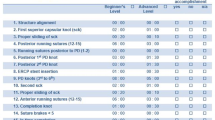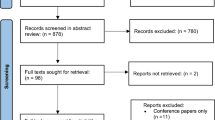Abstract
Background
Recent studies have correlated surgical skill measured by video-based assessment with improved clinical outcomes. Certain automated measures of operative performance in robotic surgery can be gathered beyond video review called objective performance indicators (OPIs). We explore the relationship between OPIs, surgeon experience, and postoperative recovery, hypothesizing that more efficient dissection will be associated with experience.
Methods
Fifty-six robotic cholecystectomies between February 2022 and March 2023 were recorded at a large tertiary referral center. Surgeon experience and clinical outcomes data from the EMR were obtained for all 56 cases with 10 completing the QOL survey. Two steps of robotic cholecystectomies were reviewed: dissection of Calot's triangle (DCT) and dissection of the gallbladder from the liver (DGL). Postoperative recovery was measured using the SF-36 well-being survey. Univariate analysis was conducted using Pearson’s coefficient.
Results
Increased operative experience was associated with more efficient camera and instrument movements. DCT had 7 and DGL had 31 of 41 OPIs that correlated with experience. With respect to DGL, more experienced surgeons had reduced step duration and instrument path length and increased camera and instrument speeds.
Conclusions
Several OPIs correlate with surgical experience and may form the basis of more instructive feedback for trainees and less experienced surgeons in improving intraoperative technique.

Similar content being viewed by others
References
Birkmeyer JD, Finks JF, O’Reilly A, Oerline M, Carlin AM, Nunn AR, Dimick J, Banerjee J, Birkmeyer NJO (2013) Surgical skill and complication rates after bariatric surgery. New Engl J Med 369(15):1434–1442. https://doi.org/10.1056/nejmsa1300625
Pernar LIM, Robertson FC, Tavakkoli A, Sheu EG, Brooks DC, Smink DS (2017) An appraisal of the learning curve in robotic general surgery. Surg Endosc 31(11):4583–4596. https://doi.org/10.1007/s00464-017-5520-2
Curtis NJ, Foster JD, Miskovic D, Brown CSB, Hewett PJ, Abbott S, Hanna GB, Stevenson ARL, Francis NK (2020) Association of surgical skill assessment with clinical outcomes in cancer surgery. JAMA Surg 155(7):590–598. https://doi.org/10.1001/jamasurg.2020.1004
Brajcich BC, Stulberg JJ, Palis BE, Chung JW, Huang R, Nelson H, Bilimoria KY (2021) Association between surgical technical skill and long-term survival for colon cancer. JAMA Oncol 7(1):127–129. https://doi.org/10.1001/jamaoncol.2020.5462
Stulberg JJ, Huang R, Kreutzer L, Ban K, Champagne BJ, Steele SR, Johnson JK, Holl JL, Greenberg CC, Bilimoria KY (2020) Association between surgeon technical skills and patient outcomes. JAMA Surg 155(10):960–968. https://doi.org/10.1001/jamasurg.2020.3007
Brown KC, Bhattacharyya KD, Kulason S, Zia A, Jarc A (2020) How to bring surgery to the next level: interpretable skills assessment in robotic-assisted surgery. Visceral Med 36(6):463–470. https://doi.org/10.1159/000512437
Chen J, Cheng N, Cacciamani G, Oh P, Lin-Brande M, Remulla D, Gill IS, Hung AJ (2019) Objective assessment of robotic surgical technical skill: a systematic review. J Urol 201(3):461–469. https://doi.org/10.1016/j.juro.2018.06.078
Ma R, Lee RS, Nguyen JH, Cowan A, Haque TF, You J, Robert SI, Cen S, Jarc A, Gill IS, Hung AJ (2022) Tailored feedback based on clinically relevant performance metrics expedites the acquisition of robotic suturing skills—an unblinded pilot randomized controlled trial. J Urol. https://doi.org/10.1097/JU.0000000000002691
Trinh L, Mingo S, Vanstrum EB, Sanford DI, Aastha MR, Nguyen JH, Liu Y, Hun AJ (2022) Survival analysis using surgeon skill metrics and patient factors to predict urinary continence recovery after robot-assisted radical prostatectomy. Eur Urol Focus 8(2):623–630. https://doi.org/10.1016/j.euf.2021.04.001
Chen A, Ghodoussipour S, Titus MB, Nguyen JH, Chen J, Ma R, Hung AJ (2020) Comparison of clinical outcomes and automated performance metrics in robot-assisted radical prostatectomy with and without trainee involvement. World J Urol 38(7):1615–1621. https://doi.org/10.1007/s00345-019-03010-3
Ghodoussipour S, Reddy SS, Ma R, Huang D, Nguyen J, Hung AJ (2021) An objective assessment of performance during robotic partial nephrectomy: validation and correlation of automated performance metrics with intraoperative outcomes. J Urol 205(5):1294–1302. https://doi.org/10.1097/JU.0000000000001557
Singh R, Brunt ML (2017) Critical view of safety—its feasibility and efficacy in preventing bile duct injuries. Ann Laparosc Endosc Surg 3(1):2. https://doi.org/10.21037/ales.2017.12.04
Acknowledgements
None.
Funding
The work of the IPAL is supported by a prior Society of American Gastrointestinal and Endoscopic Surgeons (SAGES) Robotic Surgery Grant (2020) and an education grant from the Hugoton Foundation. The work is produced in collaboration with Intuitive Surgical, Inc for which a collaborative agreement is in place for the use of the IDR and compensation for administrative and IRB fees (2022—Ongoing, non-grant support). Ongoing work on the Intuitive Data Recorder is supported by a 2022 Technology Grant from Intuitive Surgical (2022).
Author information
Authors and Affiliations
Corresponding author
Ethics declarations
Disclosures
Dr. Filicori is a consultant for Boston Scientific. Dr. Bitner and Dr. Addison have prior consulting affiliations with Deep Surgery, Inc. Dr. Yee and Dr. Jarc are full time employees of Intuitive Surgical, Inc. Dr. Choksi, Dr. Carsky, Dr. Andrews, Dr. Kowalski, Dr. Reisner, Dr. Farrell, Dr. Jain, and Dr. Dronsky have no conflicts of interest to disclose.
Additional information
Publisher's Note
Springer Nature remains neutral with regard to jurisdictional claims in published maps and institutional affiliations.
Rights and permissions
Springer Nature or its licensor (e.g. a society or other partner) holds exclusive rights to this article under a publishing agreement with the author(s) or other rightsholder(s); author self-archiving of the accepted manuscript version of this article is solely governed by the terms of such publishing agreement and applicable law.
About this article
Cite this article
Bitner, D.P., Choksi, S., Carsky, K. et al. Kinematic metrics and surgeon experience in robotic cholecystectomies: a pilot study on breaking down technical performance. Surg Endosc 38, 913–921 (2024). https://doi.org/10.1007/s00464-023-10481-4
Received:
Accepted:
Published:
Issue Date:
DOI: https://doi.org/10.1007/s00464-023-10481-4




